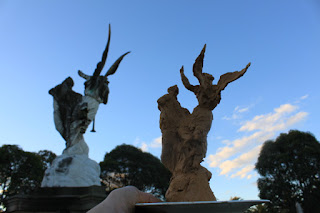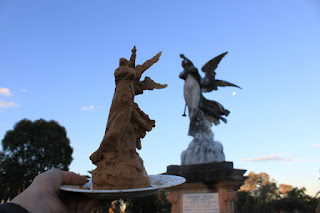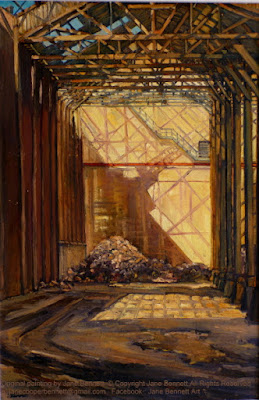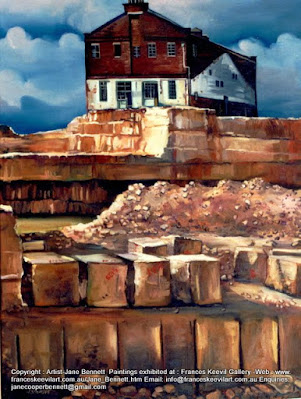The Lands Department
building 22-33 Bridge Street Sydney, is one of the most outstanding
surviving Victorian buildings in Sydney. The building had been used
continuously for the purpose which it was designed for - as the
administrative head office of Department of Lands.
Unfortunately, this will soon change.
I don't know whether all the original features which makes this building so wonderful will be retained, but I thought that I should attempt to paint it while it is still in its original state.
I managed to set up my easel in Macquarie Place Park, directly opposite the corner of Bridge and Gresham street.
Unfortunately, this will soon change.
I don't know whether all the original features which makes this building so wonderful will be retained, but I thought that I should attempt to paint it while it is still in its original state.
I managed to set up my easel in Macquarie Place Park, directly opposite the corner of Bridge and Gresham street.
U235'Statues of Explorers', Lands Department
2015 oil on canvas 31 x 31cm
Enquiries
2015 oil on canvas 31 x 31cm
Enquiries
James Barnet was the architect mostly responsible for the design of the Lands Department building, although Walter Liberty Vernon and William Edmund Kemp also made contributions.
 |
| U235'Statues of Explorers', Lands Department 2015 oil on canvas 31 x 31cm Enquiries |
The foundation stone was laid in 1876 by the Minister of Lands and it was completed in 1893. The Renaissance Revival Style facades are of dressed Pyrmont sandstone
The ground, first, and second floors have pilasters and entablatures of the Doric, Ionic and Corinthian orders respectively, each standing on appropriate pedestals.
 |
| U235'Statues of Explorers', Lands Department 2015 oil on canvas 31 x 31cm Enquiries |
The clock tower has a copper onion-shaped dome which was allegedly influenced by the shape of the water carafe of Sir Henry Parkes.
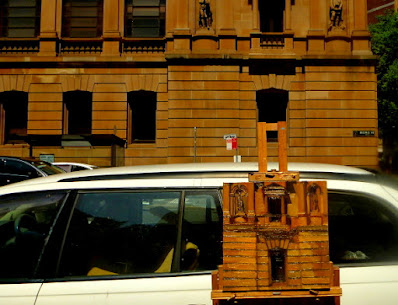 |
| U235'Statues of Explorers', Lands Department 2015 oil on canvas 31 x 31cm Enquiries |
The best of Classical tradition was fused with the most cutting edge technology for the period. Heating, lighting, ventilation and a system of communication involving speaking through tubes and operating pneumatic bells was incorporated in the design.
Builder John Young
introduced one of Sydney’s first reinforced-concrete floor slabs, with
concrete vaults to improve fire resistance.
 |
| U235'Statues of Explorers', Lands Department 2015 oil on canvas 31 x 31cm Enquiries |
There are 12 niches on each facade, which were all intended to be filled with sculptures of explorers or legislators who made a major contribution to the settlement of the nation.
Although 48 men were nominated by the architect as being suitable subjects, most were rejected and only 23 statues were commissioned, leaving 25 niches unfilled.
In 2010-11
a new statue of colonial surveyor James Meehan (1774-1826) was created
and placed in an empty niche on corner of Loftus/Bent Streets.
 |
| U235'Statues of Explorers', Lands Department 2015 oil on canvas 31 x 31cm Enquiries |
In my painting the statue of the botanist Sir Joseph Banks is on the left, and the statue of the explorer Sturt on the right.
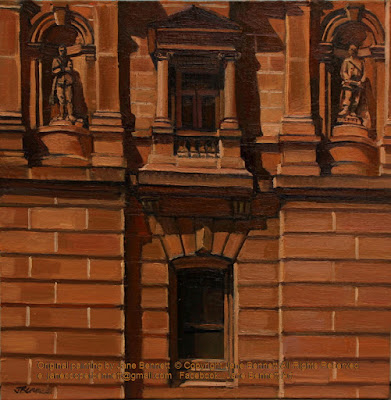 |
| U235'Statues of Explorers', Lands Department 2015 oil on canvas 31 x 31cm Enquiries |
To protect the building from unsympathetic development, a Permanent Conservation Order was passed by the NSW Heritage Council.
However, although it is one of the most beautiful and historic buildings in Australia, it still faces an uncertain future.
Both Sydney’s historic
The hotel will open in 2021 after the government employees finally leave in 2018.
Related Posts



.jpg)
.jpg)
.jpg)
.jpg)
.jpg)
.jpg)










